






The industrial chain of nickel is relatively complex, and there are many interlaced links in the process route, which affects the whole body. The most frequently asked question recently is whether Ferro-Nickel can produce high matte. What is the difference between the production of nickel sulfate from intermediate products and the production of nickel sulfate from nickel beans? Is the production line between nickel beans and nickel plates the same? can they be converted into each other? When process issues are mixed with market economy issues, it is difficult to judge which links will be affected after some news comes out, such as the hot issues discussed in the past two days. What will be the impact on the price of nickel after the channel from laterite to high matte is fully opened and produced on a large scale? The most important thing to know is what is high matte? What kind of production does it mainly use, and what is it used to produce? Why there is no production before and so on. In this article, we will not talk about the market, but only about the technology. We have summed up a lot of previous articles and production experience, and given a relatively comprehensive production process of most products in the nickel industry chain, hoping to be helpful to you.
1. Overview of nickel industry chain
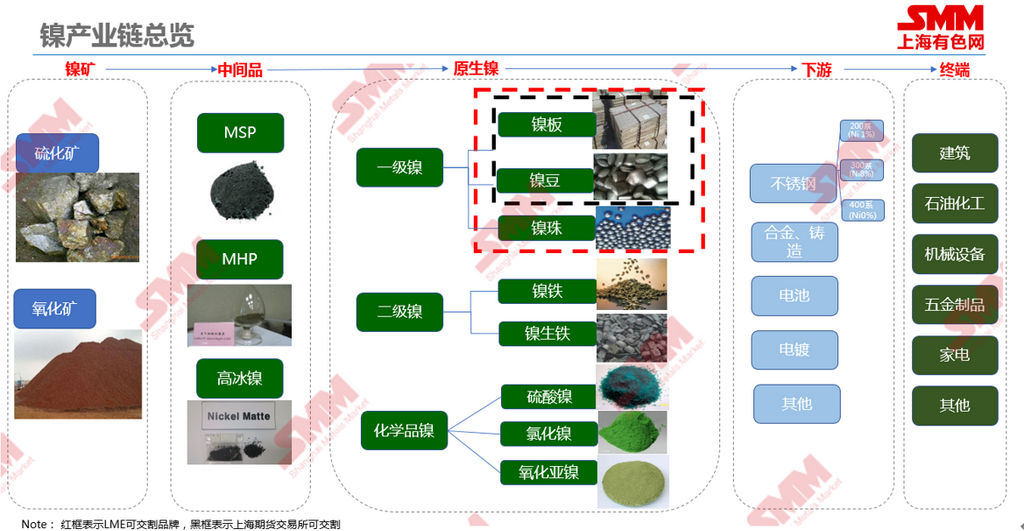
two。 Smelting difference between laterite nickel ore and nickel sulphide ore
Nickel belongs to siderophile element, and its content in the earth is second only to silicon, oxygen, iron and magnesium, ranking fifth. It has the highest content of nickel in the core and is a natural Ni-Fe alloy. In the crust, the nickel content of mafic rocks is higher than that of aluminosilicate rocks. For example, the nickel content of peridotite is 1000 times that of granite, and that of gabbro is 80 times that of granite. More than 50 kinds of nickel-bearing minerals are known. Among them, sulfides, such as nickel pyrite, purple pyrite and other free nickel sulphide forms exist, and a considerable part of nickel occurs in pyrrhotite as isomorphisms. In nickel oxide ore, nickel laterite has high iron content, low silicon and magnesium content, 1% 2% nickel, and nickel silicate has low iron content, high silicon and magnesium content, and nickel content is 1.6%-4.0%. The development and utilization of nickel oxide ore is mainly nickel laterite, which is formed by the weathering of ultrabasic rocks. Nickel mainly exists in the form of nickel limonite (rarely crystallized to non-crystalline iron oxide). Ni2+ has strong thiophile. In the early stage of magmatic crystallization, under the premise of a certain content of nickel, the enrichment degree of nickel in rocks depends on the fugacity of sulfur. When there is enough sulfur, nickel reacts with sulfur and sulfur-like substances (arsenic, antimony) to form nickel-containing sulfides, which are separated before silicic acid minerals are crystallized to form sulfur (or arsenic) compounds of nickel (such as goethite, pyrrhotite, nickel pyrite, red arsenite, arsenite, nickel). The so-called magnesium-silicon-nickel ore (that is, nickel silicate ore) is the general name of a series of magnesium minerals from serpentine to clay-like serpentine and saponite. Under the condition of oxidation, part of magnesium is replaced by nickel. Nickel oxide, like nickel sulfide, has become an important source of nickel. Nickel ores are mainly divided into copper-nickel sulphide ore and nickel oxide ore, and their mineral processing and smelting processes are completely different.
2.1 Nickel sulphide ore
Flotation is the main mineral processing method for copper-nickel ore, with flotation and magnetic separation as the auxiliary. The selection of the technological process depends on the type of raw materials, the composition and the requirements of the product. Most of the sulphide ores are smelted by matte smelting, that is, all kinds of nickel sulphide ores are smelted into low nickel matte by different pyrometallurgical processes, and then the low nickel matte is blown into high nickel matte by converter, that is, nickel sulfide and copper sulfide alloy. High nickel matte is then refined by different nickel refineries to produce different nickel products. In addition to producing high nickel matte, Terrafame in Finland uses biological heap leaching to produce MSP, and reprocess it into downstream products. The details of smelting are described in detail below.
2.2 laterite nickel ore
The smelting methods of nickel oxide ore can also be divided into two types: fire smelting and wet smelting. Among them, pyrometallurgy can be subdivided into ferronickel process and reduction sulfur-making process. Pyrometallurgy is suitable for dealing with nickel ores with high silicon and magnesium content, which has the advantages of good adaptability, high recovery rate and high energy consumption; the commonly used wet method is mainly HPAL high-pressure acid leaching, ammonia leaching is relatively rare, and the advantages of laterite nickel hydrometallurgy are low energy consumption, high recovery rate, but high pre-investment cost and long construction cycle.
The global reserve of nickel laterite is much higher than that of nickel sulphide, so the development of nickel laterite smelting process has been paid more and more attention in recent years, especially in the past two years with the development of new energy, the construction of wet smelting process is in full swing.
1. Two processes of pyrometallurgy: nickel-iron process and reduction sulfur production process. Nickel-iron process is common in China is the RKEF process, EF process and BF process, they are aimed at different ore grades, we will explain this part in detail when we drop to the nickel-iron smelting process; while the product of another reduction sulfur production process is nickel matte, which is basically the same as the nickel matte produced by nickel sulphide ore, this process is also a process that has been concerned again recently, as detailed below.
two。 There are two processes of wet smelting: ammonia leaching process and high pressure acid leaching process. The ammonia leaching process is generally only suitable for the treatment of surface laterite ore, while the ore with low magnesium and aluminum content and high iron content is suitable for high pressure acid leaching process.
The advantages and disadvantages of pyrometallurgical and hydrometallurgical processes for laterite nickel ore are shown in figure 2 below:

2.3 production process list of global nickel smelting enterprises
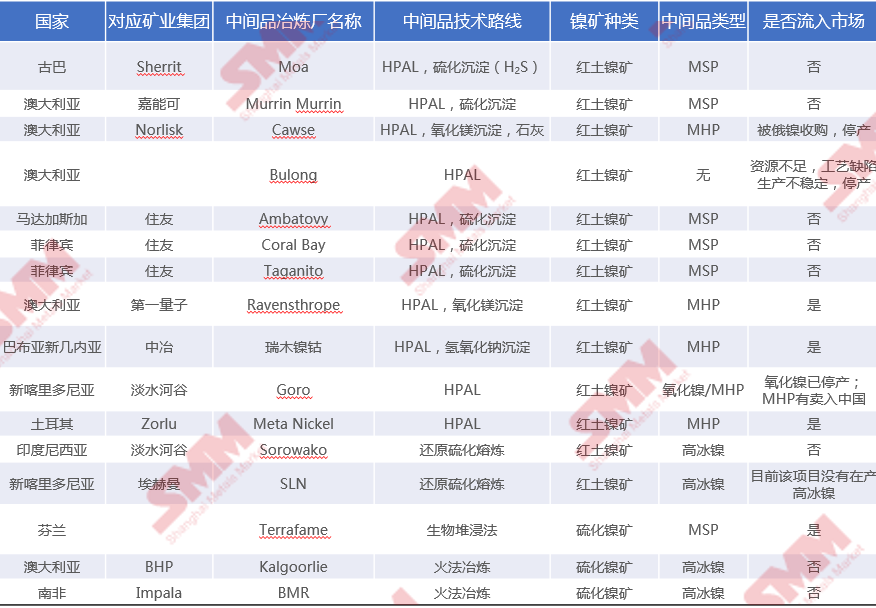

3 smelting process of intermediate products
3.1Wet intermediate MSP/MHP smelting process
Most of the raw materials of wet process intermediates are laterite nickel ores, and nickel sulphide ores are mostly used to produce high matte nickel. Except for the production of MSP, by biological heap leaching of Finnish Terrafame, there are no other wet process intermediates produced by nickel sulphide ores at present.
The treatment of nickel laterite by wet process is mainly divided into ammonia leaching process (RRAL) and pressurized sulfuric acid leaching process (HPAL). Up to now, most of the main processes used in large-scale nickel laterite hydrometallurgical plants all over the world are HPAL. However, wet smelting also has obvious disadvantages, such as large emissions of solid waste and polluting gases. Nearly 97% of the hydrometallurgical ores contain high content of Fe (100.45% of the total) and a small amount of Cr are all discarded as solid wastes; wet smelting uses liquid acid or ammonia as the leaching agent of Ni and Co, and after use, except for partial recovery and utilization, the rest are discharged into rivers or into waste pools after liquid treatment. Wet smelting will also produce a large number of CO2 gas emissions, all of which belong to the total emission of three wastes. Overseas wet intermediate products projects mostly use the following processes to produce wet intermediate products:
1.HPAL high pressure acid leaching technology
High-pressure acid leaching process is a relatively mature wet smelting process of laterite nickel ore at present, and most of the projects in the world use this method, but different intermediate products are produced in the later stage, and both MSP and MHP can be produced. HPAL technology was first adopted in (Moa), a Maoa factory in Cuba. This process is suitable for the treatment of limonite-type laterite nickel ore with relatively low MgO content. The biggest advantage of HPAL process is that the recovery of nickel and cobalt can reach more than 90% 4. HPAL process MHP production process: feed preparation and rough selection to improve the grade (pulping dense)-HPAL pressure acid leaching (adding acid and steam, carried out in a high pressure vessel)-concentration and neutralization reaction (adding lime and flocculant, the process neutralizes some materials to tailings reservoir after reaction)-mixed hydroxide precipitation. This method is used in a large overseas smelter, as shown in figure 4 below.

HPAL process for MSP production: feed preparation and roughing to improve grade (pulping dense)-HPAL pressure acid leaching (adding acid and steam, carried out in a high pressure vessel)-neutralization of iron and aluminum-(addition of H2S) selective zinc removal-sulphide precipitation-nickel-cobalt sulfide mixture
(CBNC), the Coral Bay Nickel company invested by Sumitomo in the Philippines, was previously produced in this way.
In the first half of the two processes of pressure acid leaching of laterite nickel ore to produce MSP/MHP, the technological process and equipment of the original pulp storage, pulp density, pressure leaching, pulp neutralization, CCD solution neutralization (removal of iron, aluminum and other impurities) and solution storage are basically the same, only the product precipitation process is different. The two product schemes have their own advantages and disadvantages. The production of nickel-cobalt sulphide mixture has the advantages of high nickel and cobalt grade, less impurities, favorable for follow-up smelting and low transportation volume. However, the disadvantage is that an additional investment of more than 100 million US dollars is needed to build hydrogen production plants, H2S plants and small-scale nitrogen plants.
RRAL process is also called Caron process, and the process flow is as follows:
Surface laterite nickel ore-reduction roasting-nickel-cobalt and partial iron alloy-multi-stage countercurrent ammonia leaching-leaching solution vulcanization precipitation-precipitation mother solution removal of iron steaming ammonia-basic nickel sulfate-calcination into nickel oxide or reduction to produce nickel powder
The mass fraction of nickel in the nickel block produced by this process can reach 90%, and the recovery rate of nickel in the whole process is 78% ~ 80%. Compared with the pyrometallurgical process, cobalt can be partially recovered with a recovery rate of 40% ~ 50%. However, the ammonia leaching method is only suitable for treating the laterite ore in the upper layer of the laterite nickel deposit, but not suitable for the ore layer with high silicon and magnesium content in the lower layer, which greatly limits the development of the ammonia leaching method. There has been no new plant to choose this process since the 1970s.
The main processes of producing wet intermediate products from nickel laterite are the above two, generally speaking, they are basically HPAL process now, and the ammonia leaching process can be understood a little.
3.2 production process of fire intermediate high matte
High nickel matte can be produced from nickel laterite or nickel sulphide ore.
At present, the process of producing high matte from laterite nickel ore is only one company in Vale, Indonesia, Sorowako, adopts the reduction vulcanization melting process, and the production process is changed as follows:
Nickel laterite is mixed with sulphur-containing materials (pyrite, gypsum)-1500-1600 ℃ blast furnace blowing (or electric furnace smelting)-low nickel matte-converter blowing-high nickel matte (high matte) or laterite-RKEF process-high nickel iron-after adding sulfur material in converter blowing-high matte.
The nickel recovery rate of this process is lower than that of RKEF process, but it has the advantages of simple production process, low investment, simple operation and low power consumption. If there is an abundant supply of sulphide iron ore or gypsum ore and the recovery of iron is not considered, sulphide smelting should be an economical and feasible option. Vulcanization smelting requires pre-drying or sintering of nickel oxide ore and absorption of low concentration SO2 flue gas from blast furnace. With the popularization of RKEF process, the process is gradually eliminated. However, due to the recent development of new energy, this process has been paid more attention to, and not only high nickel matte can be produced through the above process, but also high nickel matte can be produced through high nickel iron or hydrated nickel, and then nickel sulfate can be produced.
The production of high matte from nickel sulphide ore is the mainstream process to produce high matte. Jinchuan, Xinxin and Jean all use nickel sulphide ore to produce high matte. The intermediate products of pure nickel produced by most of the overseas nickel sulphide ores are high matte. The diversification of production equipment for high nickel matte is mainly related to the shape and grade of raw materials. And the production process basically has to go through the process of low matte FeS, Cu2S and Ni3S2, which contains 20% Moe 30% nickel and 55-65% high matte nickel. The following figure shows the common process of producing high matte nickel from nickel sulphide ore. Here is not too much about the high nickel matte smelting process, because of the consistency of the process, later when talking about pure nickel smelting will also talk about the high nickel matte smelting process in detail.

4. Pure nickel smelting process
With the above general understanding of minerals and intermediates, we continue to explore how to produce standard products-pure nickel. Usually the smelting process will go through what we call intermediate products, without going through the intermediate products directly to the pure nickel plant only the Australian Bulong that has stopped production. Here we take the smelting method of a pure nickel smelter as an example. Get a general idea of what steps you usually go through in nickel smelting.
4.1 Beneficiation
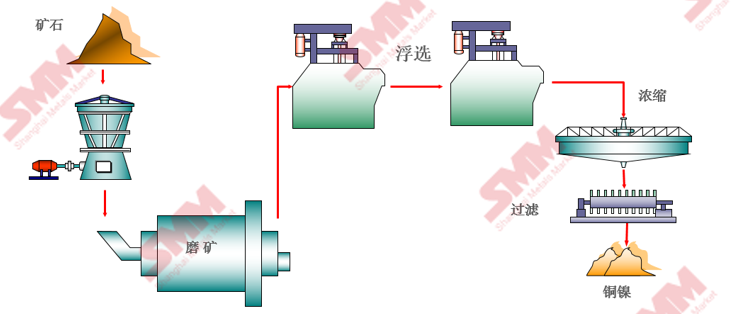
4.2 smelting of high nickel matte
The company mainly adopts three methods of pyrometallurgy: electric furnace smelting, flash furnace smelting and oxygen-rich top-blowing melting furnace smelting. Because the electric furnace is difficult to deal with large-scale smelting, the latter two methods are adopted in the follow-up improvement scheme.
Mineral processing concentrate-material preparation-dry concentrate-nickel flash furnace-low nickel matte-converter blowing-high nickel matte-ground pit slow cooling for 72 hours-sent to refinery
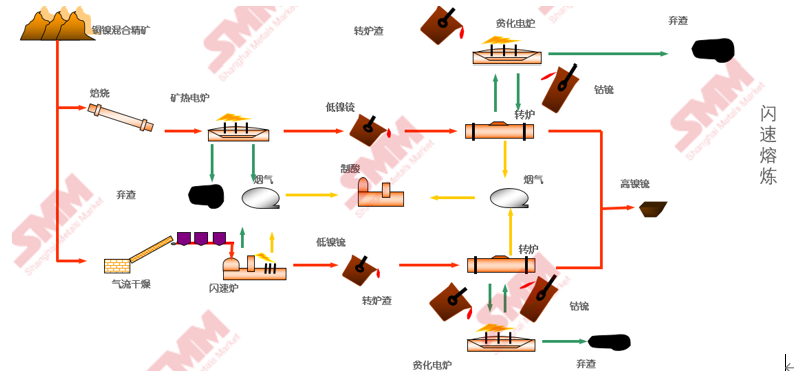
Pre-drying of nickel concentrate-oxygen-enriched top blowing furnace smelting-electric furnace sedimentation separation-horizontal converter blowing-electric furnace slag dilution
The most distinct difference between oxygen-enriched top-blowing process and flash furnace process is that it is more applicable to raw materials, especially it can deal with high magnesium raw ore, and the investment is low. If it is only a small production capacity, oxygen-enriched top-blowing smelting can be considered with less investment and quick effect. However, oxygen enrichment also has some obvious disadvantages, such as low recovery rate of effective metal, short furnace life, low equipment operation rate and so on.
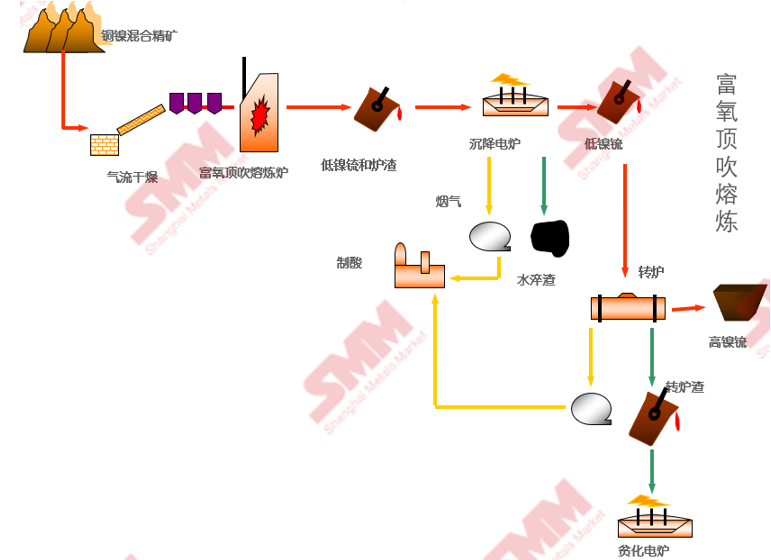
After producing high matte, the next step is the refining process:
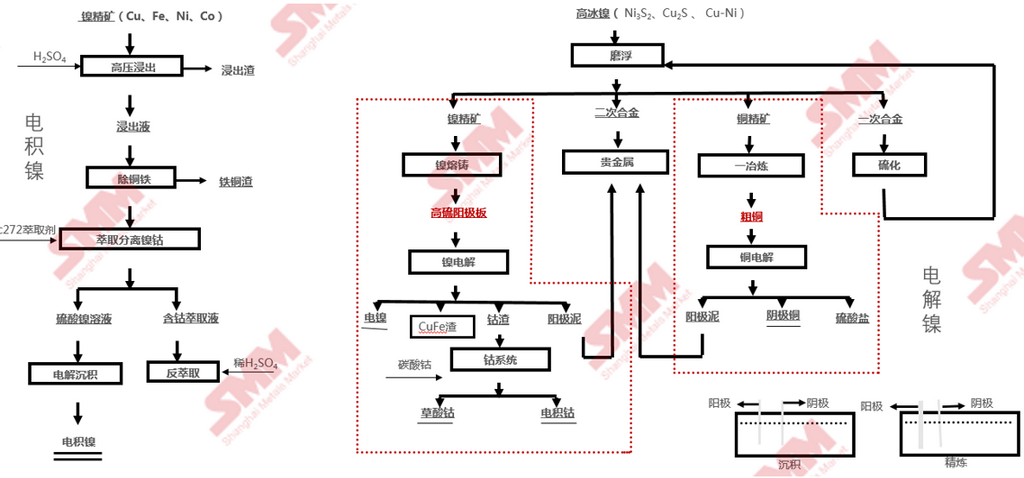
4. Smelting process of Nickel Sulfate
The raw materials of nickel sulfate include wet intermediate MSP/MHP, nickel beans and scrap, all of which are independent production lines. Left below: MHP produces Nickel Sulfate. Bottom right: MSP produces Nickel Sulfate.
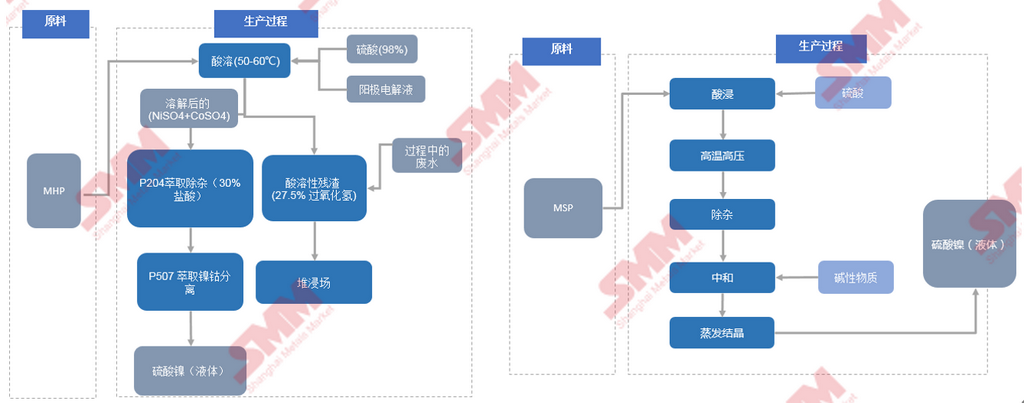
The raw materials of nickel sulfate include wet intermediate MSP/MHP, nickel beans and scrap, all of which are independent production lines. Left below: autolysis of nickel beans to produce nickel sulfate the following picture right: production of nickel sulfate from waste
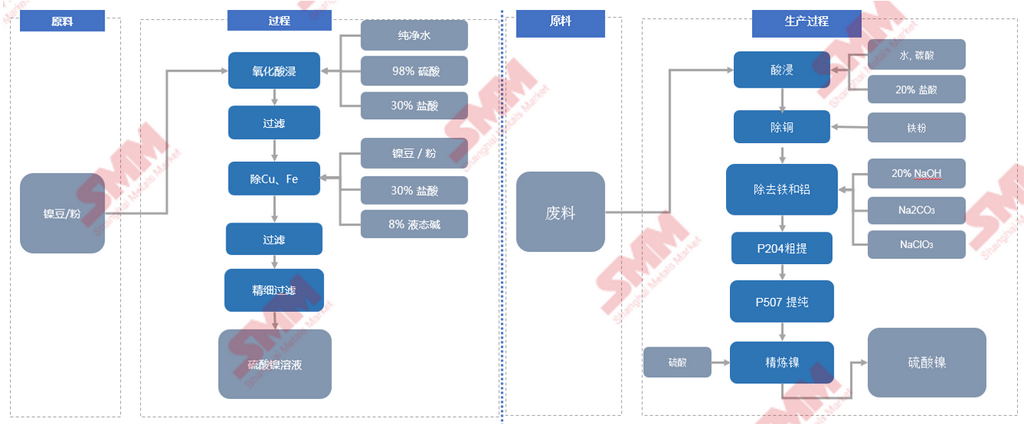
Comparison of advantages and disadvantages of various raw materials in the production of nickel sulfate:
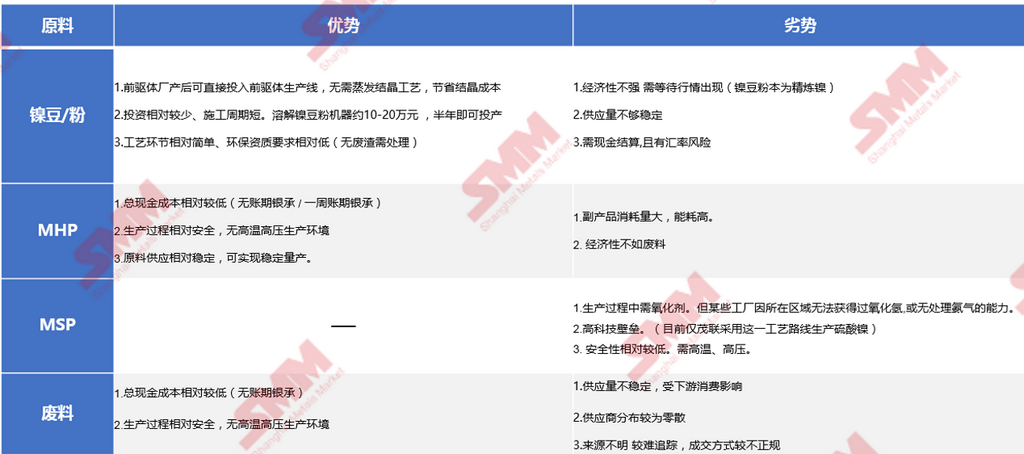
5. Ferronickel smelting process
5.1 NPI smelting process
At present, the projects for the production of NPI from low-grade nickel laterite are mainly concentrated in China and Indonesia, and the production process is mainly divided into: RKEF (rotary kiln-submerged arc furnace smelting), EF (electric furnace smelting) and BF (blast furnace smelting). At present, the main smelting process is RKEF process. The following lists the process flow of each process and the advantages and disadvantages of production:
1. RKEF (rotary kiln-submerged arc furnace smelting)
The RKEF technological process is as follows: ore batching-drying kiln drying-rotary kiln roasting-ore reheating furnace smelting-iron tapping.
The production of ferronickel by this process is a rapidly developing laterite nickel ore treatment process at present. The utility model has the advantages of mature process, simple and easy to control equipment and high production efficiency. The deficiency is that it needs to consume a lot of metallurgical coke and electric energy, high energy consumption, high production cost, too much slag in the smelting process, high melting temperature (about 1500 ℃), dust pollution and so on. Moreover, the nickel grade of the ore has a great influence on the production cost of the pyrometallurgical process, and for every 0.1% reduction of the ore nickel grade, the production cost increases by about 30.4%. In the rotary kiln, when the roasting zone temperature is about 1100 ℃, the free water and crystalline water in the nickel ore will be completely removed, and about 40% of the NiO in the nickel ore will be reduced to Ni (NiO+C thermal Ni+CO). In the submerged arc furnace, when the smelting temperature is about 1400 ℃, the remaining NiO will be directly reduced to Ni by C. Some FeO is reduced to Fe,Fe elements, accounting for about 70% of the total.
2.EF (electric furnace smelting)
The EF technological process is as follows: ore proportioning-sintering machine sintering-electric furnace smelting-iron tapping.
Compared with the RKEF process, this process has less drying and roasting in the rotary kiln. The main heat source of the rotary kiln is pulverized coal and submerged arc furnace gas, and the energy consumption is lower than that of the sintering process. The difference of smelting products is small, and the production cost is higher than that of RKEF process, so it is gradually eliminated.
3.BF (blast furnace smelting)
The BF technological process is as follows: laterite ore-dewatering sintering pelletizing-adding coke flux-blast furnace smelting-iron tapping.
The reduction smelting process is a laterite smelting process developed in China in recent years. With the adjustment of national industrial policy, a large number of ironmaking blast furnaces below 500 cubic meters have been eliminated. However, due to the shortage of nickel for stainless steel in China, a large number of imports of laterite nickel ore, and the local government in order to solve the employment problem and create tax revenue, these eliminated blast furnaces are used for the treatment of laterite nickel ore to produce nickel ferronickel containing 1.5% nickel. The smelting of ferronickel in small blast furnace is faced with policy elimination, and the smelting of 60.8% ferronickel in large blast furnace is inefficient; coke price affects the cost of ferronickel in blast furnace, resulting in slow technological progress in smelting ferronickel in blast furnace. the thinning of profits will inevitably dampen the enthusiasm of domestic blast furnace ferronickel producers. Most of the domestic blast furnace smelting low nickel ferronickel manufacturers are 200 series integrated stainless steel plants. From the technical level, the blast furnace reduction smelting process has some shortcomings, such as low blast furnace volume utilization, large coke consumption, serious sintering pollution, high phosphorus content of nickel pig iron, low nickel recovery and so on. The process is suitable for the treatment of limonite B-type laterite ore, and the grade of nickel is less than 1.2% Fe > 30% 40%.
5.2 Feni smelting process 6
At present, the commonly used feni smelting process is basically the same as the NPI smelting process, except that a refining link is added after the submerged arc furnace. The difference with NPI is that the content of nickel is higher, the content of impurity elements in Pash S is lower, the P content of NPI is generally less than 0.04%, and the P content of sulfur less than 0.4% is generally less than 0.04%. The content of S is less than 0.2%. In terms of production cost, the production cost of Feni is higher than that of NPI. In addition to the above process, feni smelting also has some other processes to explore:
Rotary kiln No.1 submerged arc furnace process (RKEF for short)
The RKEF technological process is as follows: ore proportioning-rotary kiln drying-rotary kiln roasting-furnace smelting crude nickel iron-LF furnace refining (or mechanical stirring desulphurization)-refined nickel iron water quenching-producing qualified nickel iron particles.
Brazil's Companhia do Vale do Rio Doce (Vale do Rio Doce) started the construction of the (OncaPuma) Nickel-Iron project in the state of (PARA) in Para in August 2006. the project uses the RKEF process to treat laterite nickel ore to produce nickel-iron, which is designed by Demak. The project is equipped with 2 Φ 4.6 × 45m drying kilns, 2 Φ 6 × 135m rotary kilns and 2 120000 kVA rectangular submerged arc furnaces (currently the highest power in the world), with an annual output of 220000 tons of alloy (grade 25%) and 52000 tons of nickel.
Rotary kiln magnetic separation
The technological process of rotary kiln-magnetic separation is as follows: raw ore grinding and pulverized coal mixed pellet-rotary kiln drying / high temperature reduction roasting-roasting ore grinding fine pulp-gravity separation and magnetic separation
The rotary kiln-magnetic separation process is also known as direct reduction process. At present, only Dajiangshan smelter of Japanese Metallurgical Company adopts this process. This process is recognized as the most economical method for the treatment of laterite nickel ore at present, which is characterized by low production cost, 85% of energy consumption is provided by coal, and coal consumption per ton of ore consumes 160 to 180 kg. The electric furnace smelting nickel iron process energy consumption of more than 80% is provided by electric energy, tons of ore power consumption 560~600kwh. However, the main problem in this process is the ring formation and recovery rate of the rotary kiln. Although the Dajiangshan smelter has been improved many times, the process technology is still not stable enough, and its production scale is still about 10,000 tons of nickel per year after decades. The technical key of this process is the temperature control of the mixing and reduction roasting process of pulverized coal and ore. The process is suitable for the treatment of magnesia silicate laterite type A, with a nickel grade of 0.7-1.2% and an iron content of 811%. These pilot production plants are either too high in production costs or difficult to operate, and they are unable to produce on a large scale, and many of them just stop at the stage of theoretical research and have no industrial production. Therefore, the rotary kiln-magnetic separation process still needs to be constantly explored and pushed forward.
Rotary hearth furnace + melting furnace
A new method of smelting nickel laterite by rotary hearth furnace using coal gas or natural gas as fuel, using coal gas or natural gas as fuel, non-coking coal as reductant and nickel laterite as raw material. The smelting method of producing ferronickel by rotary hearth furnace and reduction melting furnace. The content of nickel in the raw material of laterite nickel ore is 0.8% to 3.0%. This smelting method has the advantages of short technological process, simple operation, easy control, strong raw material adaptability, low energy consumption, high heat price ratio of fuel, less pollution, low equipment investment, low production cost and high nickel recovery. It is most suitable to invest and build plants in areas where electric power resources are scarce and coal resources are rich. This process is suitable for the treatment of magnesia silicate laterite ore with a Ni grade of 0.8% to 3.0% and an iron content of 15% to 20%. At present, most of China uses rotary hearth furnace to directly reduce iron ore or metallurgical dust (mud) to produce sponge iron, which is used in blast furnace or directly used in steelmaking converter raw materials, but there is no application example in the production of nickel iron from laterite nickel ore. The main reason is that the thermal efficiency of the rotary hearth furnace is low, and the raw materials must be finely ground and pelletized, and the raw ball must be dried. The strength and moisture content of the ball are very important to the operation stability of the rotary hearth furnace. At the same time, in terms of investment and production cost, compared with the mature RKEF process, there is no obvious advantage. Therefore, it is necessary to further study the critical control points of the rotary hearth furnace to realize the one-step production of nickel-iron beads, which reflects the advantages of the rotary hearth furnace.
Limited by the sources of nickel ore in China, the amount of high-grade nickel ore is very small, and the congenital conditions for Feni production are insufficient, because NPI has been developed to adapt to the smelting of low-and medium-grade nickel ore. Feni manufacturers are all overseas smelters, and the list and production capacity are as follows:
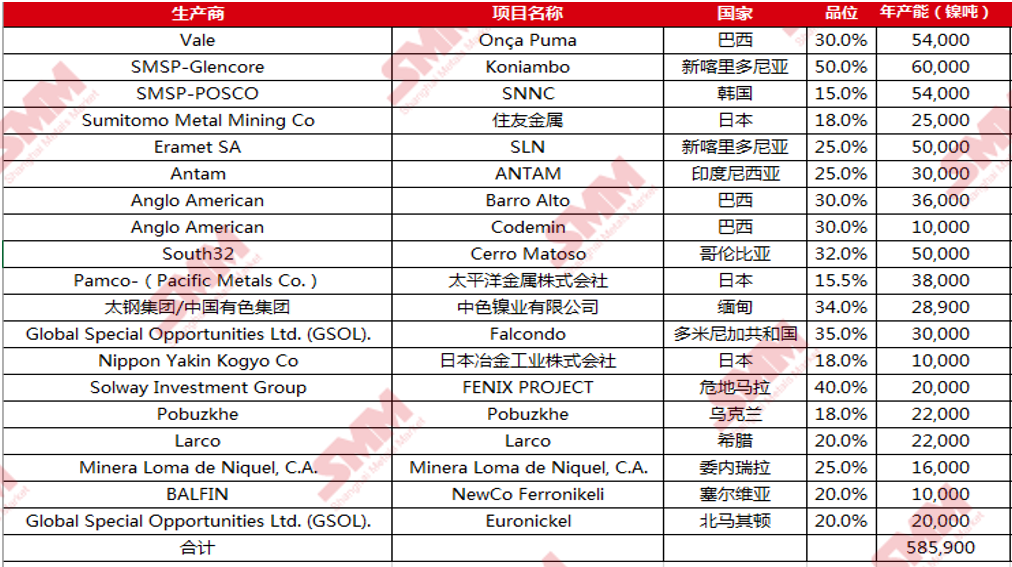
6. Stainless steel smelting process
6.1 Pictures of common smelting equipment
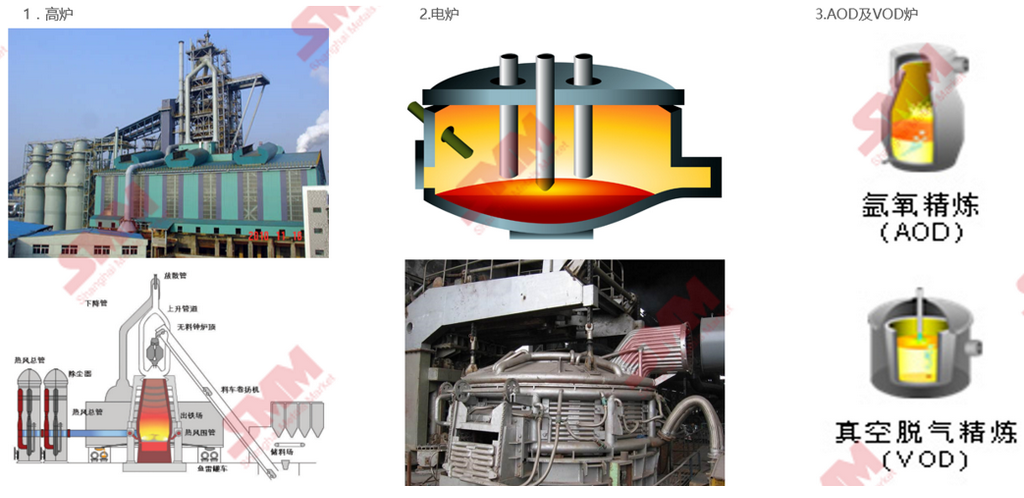
At present, there are one-step, two-step and three-step smelting methods of stainless steel in the world. The so-called "one step, two steps" mainly depends on passing through several major equipment.
One step:
The early one-step method refers to the completion of scrap iron melting, decarbonization, reduction, refining and other processes in an electric furnace, smelting the charge into stainless steel in one step, but the defects of this smelting process are obvious. the completion of all smelting in one furnace means that the smelting process is longer, and the smelting environment is single, and the harmful elements or alloying treatment that need different environments can not be well taken into account, and the production cost is also high. Therefore, it is gradually eliminated, but the new step smelting method adopted by domestic 400 series steel mills is relatively more economical. The low phosphorus hot metal produced by blast furnace goes directly into AOD (argon oxygen refining furnace) for decarburization and alloying treatment. The integrated 200 series stainless steel plant also adopts the modified production method, but the small blast furnace produces low-nickel hot metal.
Two-step approach:
The so-called two-step method is actually the process of adding an one-step electric furnace or medium frequency furnace before the refining furnace, that is, EF furnace AOD, is widely used. Electric furnace or medium frequency furnace is mainly used for the melting of cold materials such as ferronickel, ferrochromium, silicon manganese, scrap, etc., and the molten steel is transported by the ladle to the AOD furnace for further refining and alloying treatment. The less demanding 300 series stainless steel can be produced in this way.
Three-step method:
The basic technological process of the three-step method is as follows: primary furnace "combined blowing converter / AOD furnace" vacuum refining. The three-step process is an advanced method for smelting stainless steel with good product quality. it is not only suitable for specialized manufacturers, but also suitable for stainless steel production in joint iron and steel enterprises.
In addition to the above stainless steel smelting methods, some 300 series integrated stainless steel plants mostly adopt the production process from hot metal to stainless steel, the production process is: RKEF (rotary kiln electric furnace) + AOD (argon oxygen refining furnace), and the rest of the cold material can be refined by medium frequency furnace or electric furnace after melting and adding AOD furnace.

The molten steel from the furnace is then similar to the smelting process of plain carbon steel, entering the tundish, the mold, and the continuous caster to pull out the billet, followed by hot rolling, cold rolling, and finally a smooth and flat cold-rolled steel coil.
The above is a summary of the production process of each link of the nickel industry chain by SMM. If you have any questions, you are welcome to criticize and correct them.
References:
1 Baidu Encyclopedia-Nickel Mine 2 "maturity Analysis of High pressure Acid leaching Technology of laterite Nickel Ore" 3 "three main processes of extracting Nickel Metal from laterite Nickel Ore" 4 "recovery of Nickel and Cobalt from Nickel laterite by High pressure Acid leaching" Technical maturity Analysis of High pressure Acid leaching smelting Project of laterite Nickel Ore "6 Zhi Minghu small stage-Nickel: chapter 4, Chapter 2" Nickel Iron-smelting process "
Recommended reading:
[SMM brief Review] Shanghai Nickel fell by the limit! A piece of news triggered the collapse of the nickel market, the balance of supply and demand will change?
[SMM comment] Nickel limit falls, spot price rises, terminal procurement is limited, market wait-and-see mood is strong.
[summary of SMM Morning meeting] the signing agreement of Indonesia's high ice nickel project draws the attention of the market to the pricing logic of the nickel market and returns to the fundamentals of primary nickel.
For queries, please contact Lemon Zhao at lemonzhao@smm.cn
For more information on how to access our research reports, please email service.en@smm.cn